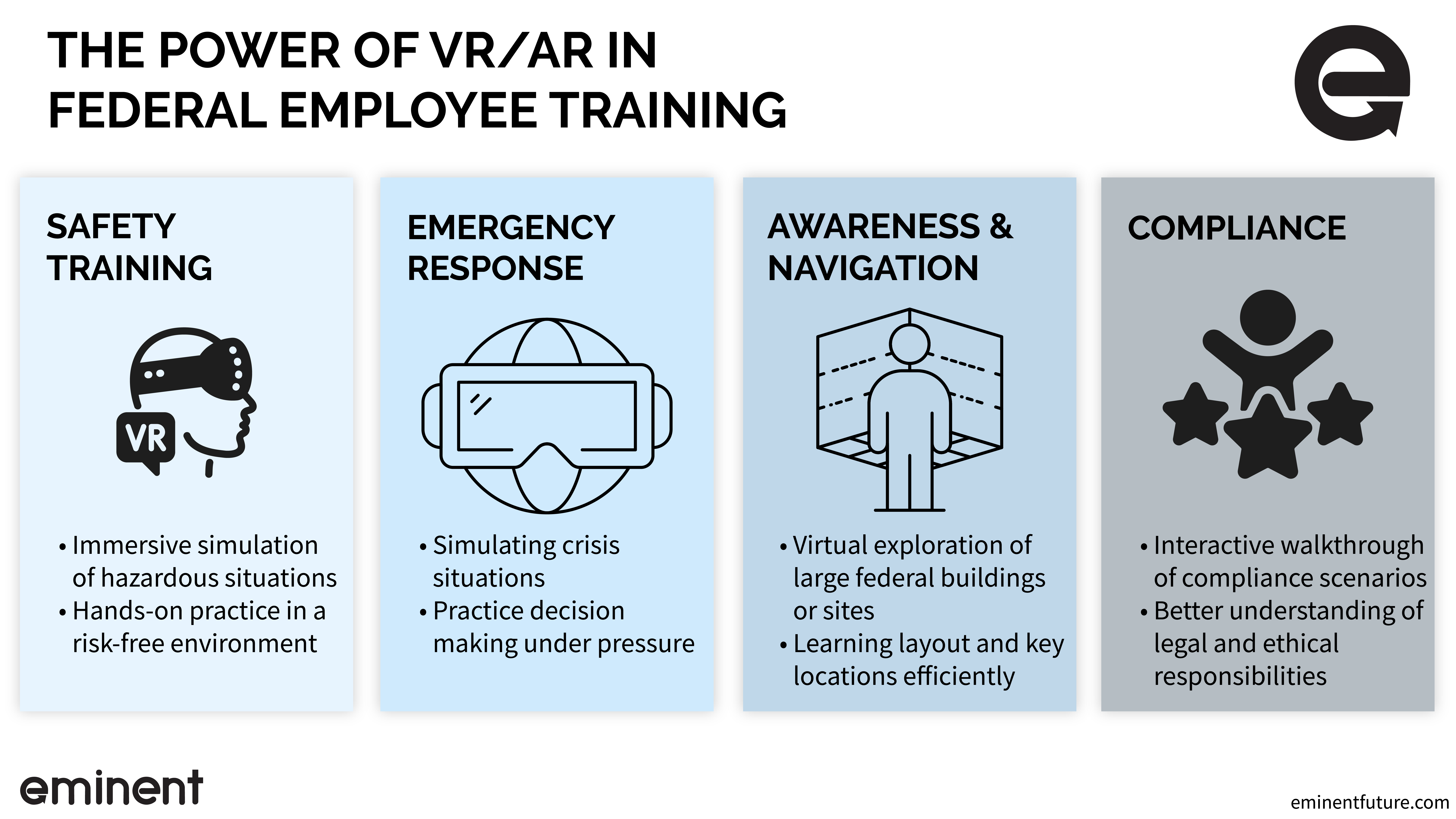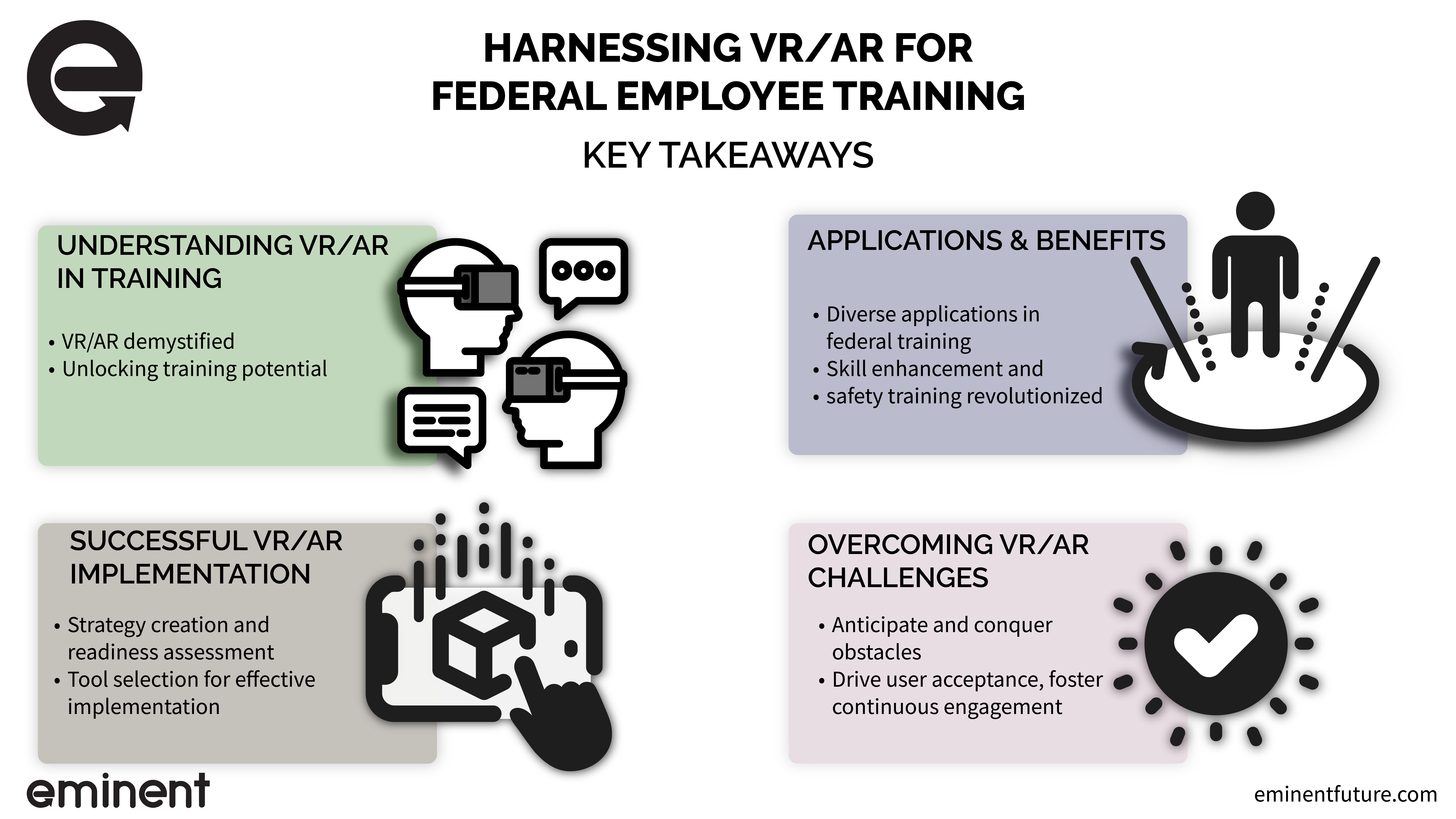
As we stand on the brink of a digital revolution, advanced technologies such as Virtual Reality (VR) and Augmented Reality (AR) are making waves across various sectors, including federal training. These immersive technologies are poised to transform how we learn, work, and evolve. But how can federal agencies effectively leverage VR and AR for employee training? What benefits do these technologies promise, and what challenges might they pose?
This comprehensive guide explores the fascinating world of VR and AR, delving into their potential applications in federal employee training. We will traverse through their future benefits, outline a step-by-step process for their successful implementation, and provide strategies to navigate any hurdles that may arise during this digital journey.
Finally, we will shed light on quantifying the success of VR/AR training programs and examine the promising future of these technologies in federal training. Let’s dive in and uncover the transformative potential of VR and AR in creating the federal workforce of tomorrow.
What are Virtual Reality (VR) and Augmented Reality (AR)?
Virtual Reality (VR) is a digital technology that immerses users completely in a virtual environment, disconnecting them from their physical surroundings. The user’s movements and interactions are mirrored within this artificial world, creating a sense of presence and participation.
Conversely, Augmented Reality (AR) supplements the real world with digital information. It overlays computer-generated images or data onto the user’s real-world view, thus enhancing their perception and interaction with their surroundings. Unlike VR, AR maintains the user’s connection with their physical environment.

The Evolution of VR/AR in Training Programs
Though the roots of VR and AR date back to mid-20th century inventions like the Sensorama and the Headsight, their prominence in training programs has accelerated with recent technological advancements. Over the past few decades, these technologies have evolved from experimental concepts into practical tools that enhance learning and skills development in various fields, including federal training programs.
The Potential Advantages of VR/AR in Training
Incorporating VR and AR into federal employee training programs offers numerous advantages. These immersive technologies can simulate real-world scenarios in a safe, controlled digital environment. This capability allows employees to practice and fine-tune their skills without the hazards or costs associated with real-world training.
VR/AR-based training is engaging and interactive, which can enhance knowledge retention and encourage a continuous learning culture. Furthermore, these technologies provide the ability to record and analyze data from training sessions, offering valuable insights into employee performance. This feature can assist in identifying areas for improvement and personalizing training to suit individual needs.
With a clear understanding of VR and AR, we’re now ready to explore how directors can apply these technologies in federal employee training and how they can potentially transform the future of workforce development.
Exploring New Realities: Utilizing VR/AR in Federal Employee Training
The potential applications of Virtual Reality (VR) and Augmented Reality (AR) in federal employee training are vast and transformative. This section delves into the myriad ways these advanced technologies can be integrated into various training areas, highlighting their incredible versatility.
From safety training to skill enhancement and procedural mastery, VR/AR has the potential to revolutionize how federal agencies prepare their workforce for the tasks ahead. Additionally, we’ll explore the significant benefits and favorable outcomes of adopting VR/AR in these areas. Let’s uncover the exciting potential of these technologies in redefining federal employee training.

Where Can VR/AR Be Used in Federal Employee Training?
The applications of VR/AR in federal employee training are wide-ranging and transformative. Let’s look at a few key areas:
- Safety Training: VR/AR can recreate dangerous scenarios safely. For instance, firefighters can train for hazardous situations using VR simulations to practice their response without exposure to real danger. Similarly, healthcare professionals can use VR/AR to simulate medical emergencies, honing their skills without putting patients at risk.
- Skill Enhancement: VR/AR can also enhance the acquisition of new skills or refine existing ones. For instance, VR can simulate a negotiation with a foreign delegate, helping diplomats practice communication and persuasion skills in a controlled environment.
- Procedure Training: Certain federal roles require mastery of complex procedures. For instance, technicians maintaining sophisticated equipment or scientists conducting precise experiments can use VR/AR to practice these procedures, reducing the risk of errors in real-life situations.
Benefits and Outcomes of Using VR/AR in These Areas
Integrating VR/AR into federal employee training programs can yield significant benefits:
- Improved Learning Retention: Because VR/AR is immersive and interactive, it can increase engagement and, consequently, improve knowledge retention. Trainees are likelier to remember lessons learned through active participation than through passive methods like reading or listening to lectures.
- Risk Reduction: VR/AR allows employees to practice dealing with risky situations without exposing them to danger. This kind of simulated exposure safeguards employees and can prevent costly mistakes.
- Data-Driven Insights: VR/AR technologies can track and record user interactions, providing valuable data about employee performance. These insights can inform training improvements and enable personalized learning paths.
By harnessing VR/AR technologies, federal agencies can create more effective, engaging, and safer employee training experiences. The following section will discuss successfully implementing VR/AR into your training programs.
Steps to Implement VR/AR in Federal Employee Training
Navigating VR and AR technologies for team member training may seem daunting. However, a well-structured implementation approach can break down the complexities and streamline the process.
This section provides a roadmap to guide federal leaders in integrating these innovative technologies into their training strategies. We will examine everything from assessing readiness to crafting practical VR/AR training modules to bolster employee development and enhance agency operations.

Assessing Readiness and Need for VR/AR Training in Your Agency
The journey toward integrating VR/AR into your training programs begins with assessing your agency’s readiness and the absolute need for such a technological leap. Consider the following factors:
- Technical Infrastructure: Does your agency have the necessary hardware and software to support VR/AR technologies? Do you have access to adequate internet speed and bandwidth?
- Training Needs: What are the specific training needs that VR/AR can address in your agency? Are there complex procedures or dangerous scenarios that could be effectively simulated using VR/AR?
- Budget: While costs have decreased recently, implementing VR/AR technology requires a significant investment. Can your agency invest in hardware, software, and training materials?
Developing a Strategy and Plan for Implementation
Once you’ve assessed your readiness and identified the need, it’s time to develop a comprehensive VR/AR implementation strategy. This plan should include the following:
- Goals and Objectives: Define clear goals for your VR/AR training program. What specific skills or knowledge do you want to impart? How will VR/AR help achieve these objectives?
- Roles and Responsibilities: Identify the team member responsible for the program’s various aspects. Such duties include managing the technology, developing training materials, and assessing employee performance.
- Timeline: Set a realistic timeline for the implementation, including milestones for development, testing, and rollout.
Selection of Suitable VR/AR Platforms and Tools
Various VR/AR platforms and tools are available today, each with strengths and limitations. When choosing a platform, consider its compatibility with your current technical infrastructure, ease of use, and ability to meet your training needs. Such providers include Meta, HTC, as well as Google ARCore and Apple ARKit . Do your research, ask for demos, and consider seeking professional advice.
Designing Effective VR/AR Training Modules
The final step in implementing VR/AR in your training programs is designing practical training modules. Here are some tips to guide you:
- Immersive and Interactive: The power of VR/AR lies in its ability to immerse users in a virtual environment and interact with it. Design your training modules to maximize these features.
- Realistic: Make your simulations as natural as possible to increase their relevance and effectiveness.
- Engaging: Last but not least, remember that one of the main goals of using VR/AR is to increase learner engagement. Use gamification techniques and interactive elements to keep your trainees engaged and motivated.
Successfully implementing VR/AR in your training programs requires careful planning, intelligent tool selection, and creative module design. The result, however, is a more engaging and effective training program that can help your agency achieve its objectives. The following section will discuss overcoming challenges in VR/AR implementation.
Navigating the Virtual Hurdles: Overcoming Challenges in VR/AR Implementation
While the potential of VR/AR in federal employee training is immense, the journey toward their full-scale implementation can come with numerous challenges. Here we will address these potential obstacles that could range from technical to financial, and even resistance to change.
We will offer practical strategies to mitigate these challenges and provide insights on ensuring user acceptance and continuous engagement, which are integral to the success of VR/AR training programs. Let’s delve into these challenges and the ways to navigate around them.

Identifying Potential Challenges in VR/AR Implementation
While VR/AR technologies offer many benefits, their implementation can be challenging due to technical issues, financial constraints, or resistance to change in the workforce. Technical issues can involve compatibility problems with existing systems or requirements for high-speed internet for seamless VR/AR experiences.
The initial setup costs for VR/AR technologies can be high, and justifying these expenses may be tricky. Moreover, like any change in an organization, adopting VR/AR technologies might need to be improved by employees comfortable with traditional training methods.
Mitigating Challenges in VR/AR Implementation
Mitigating these challenges involves strategic planning, clear communication, and organizational support. On the technical front, conducting a thorough needs assessment and technical feasibility study before implementation can identify potential issues and solutions.
Again, regarding budgeting, directors must weigh the costs of VR/AR technologies against their long-term benefits, such as improved training effectiveness and employee productivity. To overcome resistance to change, it is essential to clearly communicate the benefits of VR/AR technologies, provide necessary training, and ensure top management support to drive their adoption.
Ensuring User Acceptance and Continuous Engagement
User acceptance and continuous engagement are critical to successfully implementing VR/AR technologies. Encouraging user acceptance can involve highlighting the benefits of VR/AR training, providing hands-on demonstrations, and ensuring the technology is easy to use.
For continuous engagement, it’s crucial to ensure that the VR/AR content is interactive, engaging and provides a valuable learning experience. Directors should establish feedback systems to understand users’ experiences and make necessary adjustments.
Quantifying Success: Measuring the Impact of VR/AR Training
As with any new initiative, measuring the success and impact of VR/AR in training programs is paramount. Let us explore the key performance indicators (KPIs) that can help gauge the effectiveness of VR/AR training initiatives.
Additionally, we will discuss various tools and methods for tracking these KPIs and explore the return on investment (ROI) for VR/AR training programs. Let’s examine how we can quantify the success of VR/AR implementations.

Identifying Key Performance Indicators (KPIs) for VR/AR Training
A comprehensive understanding of success in VR/AR training begins with identifying the right KPIs. These could include measures of learning retention, application of skills learned, user engagement levels, and feedback scores. By aligning these KPIs with your organization’s objectives, you can better evaluate the effectiveness of your VR/AR training initiatives.
Utilizing Tools and Methods for Measuring Success
Tracking and measuring these KPIs can be facilitated using various tools and methods. Many VR/AR platforms offer built-in analytics capabilities that track interactions, completion rates, and time spent on tasks. Moreover, surveys and feedback systems can provide qualitative insights into user experiences and learning outcomes.
Understanding the Return on Investment (ROI)
Understanding the ROI of VR/AR training programs can offer valuable insights into their long-term value. By comparing the costs of implementing and maintaining VR/AR technologies with their benefits—such as improved productivity, reduced training time, and decreased error rates—you can calculate the ROI. These practices can help validate the financial feasibility of VR/AR implementations and guide future investments in this technology.
Beyond Today: The Future of VR/AR in Federal Training Programs
As we navigate toward the future, the role of VR/AR in federal training programs is set to expand and evolve. Here we’ll delve into emerging trends and technologies in the field of VR/AR, speculate on their potential future applications, and offer some final thoughts on why federal agencies should seriously consider integrating VR/AR into their training strategies.

Exploring Emerging Trends and Technologies in VR/AR
Emerging VR/AR technology trends continue to open up new possibilities for training. For instance, developing more immersive, realistic VR/AR experiences could provide even more effective training scenarios. Other advancements, like AI integration and real-time analytics, promise to enhance customization and feedback.
Speculating on Potential Future Applications and Developments
We expect to see even more innovative applications in federal training programs as these technologies evolve. For example, AR overlays could provide on-the-job support and guidance, reducing the need for repetitive training. Similarly, VR could offer increasingly detailed and lifelike simulations for roles ranging from emergency response to diplomatic negotiation.
Why Federal Agencies Should Consider VR/AR for Training
Given the benefits and future potential outlined in this article, it’s clear that VR/AR technologies represent a significant opportunity for federal training programs. Not only do they offer engaging, immersive learning experiences, but they also provide a platform for safe, practical training. By integrating VR/AR technologies into their training strategies, federal agencies can equip their employees with the skills and knowledge they need to excel now and in the future.
Beyond Today: The Future of VR/AR in Federal Training Programs

As we stand on the precipice of a rapidly evolving digital landscape, the power of Virtual Reality (VR) and Augmented Reality (AR) is progressively recognized in various sectors, including federal training programs. Federal agencies can revolutionize learning experiences, enhance skill acquisition, and optimize workforce development by adopting and effectively integrating these cutting-edge technologies into training strategies.
While integrating VR and AR into training programs presents its own challenges, strategic planning and a well-structured implementation approach can help navigate these hurdles. It is also crucial to assess and track the success of these training programs to understand their impact and long-term value, facilitating continuous improvements and refinement.
Looking ahead, the applications of VR and AR are set to widen and evolve. The future of these technologies is rich with potential, promising more engaging, immersive, and practical training experiences. As federal agencies navigate the digital age, embracing VR and AR technologies in their training initiatives will future-proof their workforce and foster a culture of continuous learning and innovation.
In this digital transformation era, integrating VR and AR into federal training programs is not just an intriguing possibility—it’s an opportunity that can redefine workforce development and prepare federal employees for the challenges of tomorrow. Embracing this opportunity is a forward-thinking step toward shaping a skilled, agile, and resilient federal workforce ready to excel in an ever-changing digital landscape.



